InsideRide E-Flex Motion Rig
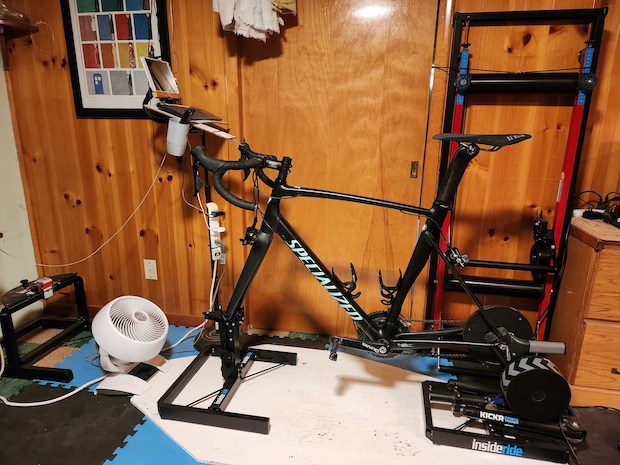
As the indoor riding boom took off, so did the DIY movement for making motion plates and rigs to make riding indoors feel more like riding outdoors. YouTube and our Slowtwitch forum are full of homemade solutions for creating motion platforms, many converging on a mix of plywood and tennis balls. Some of these motion plate concepts were brought to market by privateers and major bike brands, alike.
Enter Larry Papadopoulos of InsideRide. Larry is no stranger to making indoor riding a more natural experience. He invented a set of E-Motion rollers in 2005 that have evolved across three models (L, F, & H) and are still in demand today. The model H E-Motion rollers come with the option of a smart resistance unit that synchs with popular riding software like Wahoo RGT and Zwift and a front steering mount for people who prefer more stability. Larry draws from the same DIY spirit as the rest of the people tinkering with motion plates these past few years, but the difference is Larry is a lifelong inventor and has a company, InsideRide, that can bring his ideas from beta to market very quickly.
E-Flex
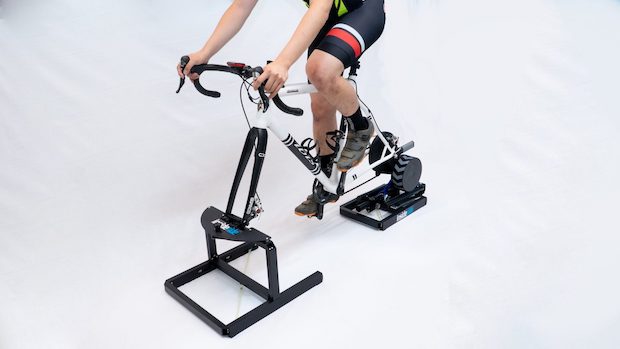
Larry first introduced a motion rig named E-Flex four years ago. The E-Flex platform consists of two pieces that attach to a Wahoo Kickr or Core and replace the two wheels of the bicycle. As you can see in the picture, the front piece of the E-Flex allows the handlebar to turn and shifts forward and backward. The Wahoo Kickr or Core mounts on the rear piece of the E-Flex and allows the trainer to tilt side to side on a center axis and shift forward and backward in concert with the front of the bike.
I’ve been riding on the E-Flex motion rig since November 2019, and I can’t imagine riding indoors without it. In fact, when I reviewed another trainer that was not compatible for mounting on the E-Flex, I was very uncomfortable being stuck to the floor and not able to move around.
To fully explain why, you have to see the E-Flex in motion. Here’s a video of Larry on the E-Flex Plus motion rig. In my experience riding the E-Flex, there are a few ways that the motion that the rig affords improves the indoor riding experience.
First, you can move around. What I mean by this is that you can shift your weight side to side and apply pressure to the pedals and handlebars in ways that make the rig shift back and forth. You don’t feel stuck in one position, as you may with a trainer that is fixed to the floor. This motion has the benefit of varying the pressure points of your contact with the saddle, much like you do outside. Because cycling is a repetitive motion injury waiting to happen, being able to vary your position, even slightly, means less chance of developing pressure point hot spots and pain in the joints. I argue that the motion that the E-Flex affords has led to less wear and tear on my knees.
Second, you can activate your core. When I first set up the E-Flex rig for my wife, Erin, I was convinced she was not going to like the side to side motion. The first generation E-Flex included a lock out to prevent the steering motion, and I introduced the rig to Erin with the steering locked out. However, Erin quickly proved me wrong; she prefers the steering because it activates her core as she moves around and shifts her weight. Erin is a recreational cyclist, who rarely rides outdoors and has now ridden over 4,000 virtual miles on the E-Flex. She, too, cannot imagine going back to a trainer without motion.
Third, I argue that there is less wear and tear on your bike with the E-Flex motion rig. Because the rig allows the bike to move with you, you aren’t putting as much force into the dropouts as you are with a trainer fixed to the floor. This has to mean less stress on the frame and fork. I’m a big guy at 6’3” and currently over 200 lbs. I can see my frame flex under me when on a trainer fixed to the floor pedaling hard. Less so on the E-Flex motion rig. I’m not rocking back and forth while pedaling (my pedal stroke is fairly smooth from riding rollers and fixed gear bikes), but the motion of the rig is compensating for forces that would otherwise be directly translated to the frame that is fixed to the motion-less trainer on the floor.
E-Flex Plus
The one criticism that users had of the original E-Flex is that the steering did not seem natural. In fact, the motion was kind of counter intuitive because the steering motion was on a horizontal plane. This meant that if you turned your bars right, your body would lean left. This never bothered me much because steering a bike comes mostly from the hips anyway, but it did feel unnatural to be turning the bars as far as they would go in the opposite direction you were leaning.
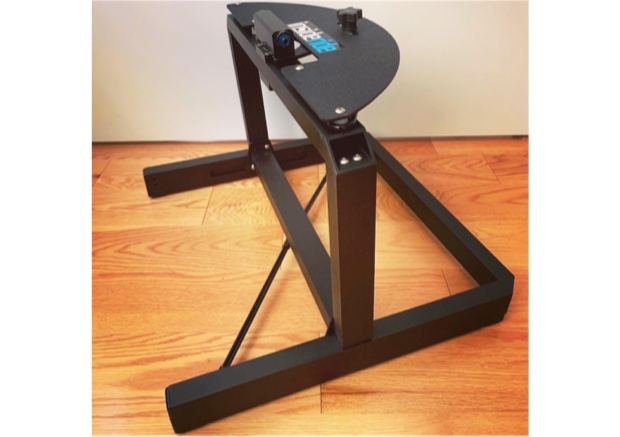
Larry took this criticism back to his shop and developed a second iteration of the front end of the E-Flex called the Plus. In this most recent version, the steering happens on two planes. Part of the motion still happens on a horizontal plane with a single pivot point in front of the axel, but the entire tower of the fork mount also leans side to side with a pivot point at the bottom of the assembly. The amount of tilt is controlled by a set of elastomers that you can change by repositioning them at a different point on the tower.
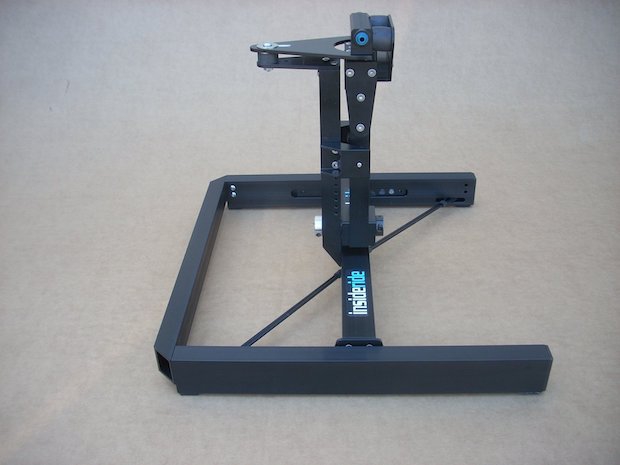
The result is a much more natural steering feel that allows you to tilt the bars instead of only turning them with the first-generation E-Flex. Riding on the E-Flex Plus feels more intuitive, and sprinting out of the saddle feels more natural. In fact, I can come pretty close to my 5- and 10-second sprinting power numbers inside on the E-Flex Plus compared to outside on the road. Definitely, to a closer degree than I could on the original E-Flex.
Adjusting the E-Flex Plus
The question then becomes how much tilting motion do you want for the front end. The E-Flex plus has eight firmness settings that are determined by removing and repositioning the elastomer spring mounts. The unit is shipped in the “soft lock” setting that allows for almost no tilting motion. Larry recommends only changing 1 or 2 settings at a time so that you can become accustomed to the motion that the E-Flex Plus rig affords. I followed his advice and worked my way all the way down to the softest setting, which was too much motion for my comfort. I found myself preferring the exact middle setting, which also worked out for Erin. Moving the elastomer spring mounts involves removing four screws and resecuring the mounts in a different place, not ideal when sharing a trainer with a partner. So, I’m glad that Erin and I agree on the middle setting.
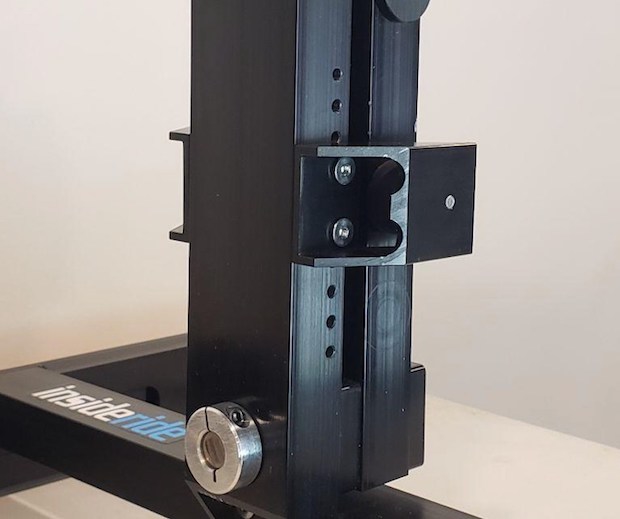
One issue that Larry and I didn’t agree on is the issue of taller riders. I suggested that because I am tall at 6’3” and ride the largest frame in just about any brand that my stack height creates a longer lever compared to a rider like Erin with a shorter stack height. I suggested that this longer lever might mean that a taller rider would want a stiffer tilt setting compared to a shorter rider to get the same amount of tilt and a similar feel.
Larry stated this isn’t the case. Now, keep in mind that Larry is a career inventor, and I am an English major.
Larry wrote:
“The idea behind the E-flex's coupled steering was to reduce the spring's influence as much as possible. The flaw in conventional rocker plates is their spring support. The springs are the only means of keeping the bike from tipping over, so they are generally quite stiff, and they also move at their own frequency, so you have to sync your cadence and ride in rhythm with the natural spring frequency. You essentially bounce from side to side at a prescribed rate. Changing your cadence or pausing for a second causes disruptions, which is why you see so many rocker plate videos with weird, jerky motion. The spring rate is never quite right, and if you remove the springs, a conventional rocker is impossible to ride.
With the E-flex, you use handlebar input to control the rocking and balance. The springs are there to lend some support, but mainly to ride no-handed and to keep the bike upright when not in use. Because of the coupled steering, it is possible to remove the springs completely and still ride it. Unlike a rocker plate, the rider controls the frequency and direction of tilt on the E flex, not the springs. The stiffest setting is for people who are less interested in balancing naturally and don't want to engage fully. In this firmness setting you'd have to fight the springs to get any significant motion. The softest settings are more for riders who want the purity and challenge of balancing with almost no spring force, which is too demanding in my opinion. The mid settings are in the theoretical "sweet spot" because they rely on the springs to some degree but still allow you to easily balance and control the rocking motion at any cadence or power level.”
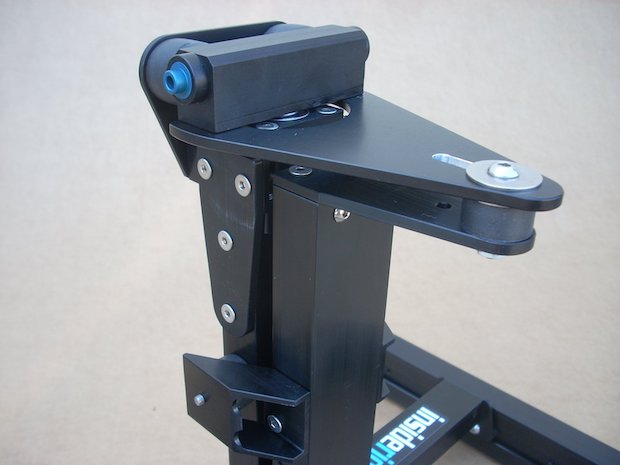
In reply, I asked:
“So, you don’t think there is anything to a taller rider being a longer lever for the coupled steering? Higher overall stack height, higher center of gravity?”
And Larry responded:
“Well…no, because if you are balanced, you don't rely on spring or arm force to hold you up. Coupled steering gives you the ability to finely control balance, which is why you can ride it even with the springs removed (though it does take some practice to do it). Even if you're 400 lbs., the force required to modulate balance does not change. Your weight should not bear against the springs. If it does, you are technically out of balance.”
It took me a while to understand, but after riding the E-Flex Plus over the winter I think I finally get what Larry is saying. Coupled steering means there are two planes for the motion, one horizontal and one vertical (side to side). If I’m riding balanced then I don’t technically need those elastomer spring mounts to keep me upright. Rather, they serve as limits to how far I can lean to one side or another. When doing intervals and other efforts that make my eyes cross, I prefer the comfort of the middle settings for applying those tilting limits. Also, when sprinting out of the saddle, which is not 100% the motion it is outside, I prefer having those middle settings when rocking the bars back and forth in the drops.
In Conclusion
If you have a Wahoo Kickr or Core (any generation), this really should be your next upgrade. Our 2nd generation Kickr has taken a beating from both of us on the E-Flex and E-Flex Plus motion rigs. We are riding a good chunk of the year indoors, here in Western New York. I warn you, though, once you go motion rig, you won’t want to go back to a trainer fixed on the floor. Both my Zwift Hub and my Lemond Revolution are loaned out to friends because of this very reason.
Coming Soon
After publishing this article and sharing it with Larry, he let me know that he just put the finishing touches on the E-Flex Plus for the Zwift Hub and will be putting it up for sale on InsideRide next week!




Start the discussion at forum.slowtwitch.com